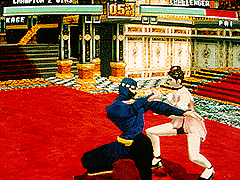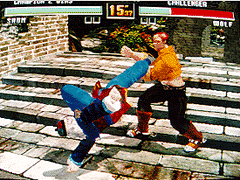Virtua Fighter 3
|
| ||||||||||||
Where do I start when reviewing Virtua Fighter 3? OK, at the beginning. VF3 is the sequel to what was the best game before it: the mind-blowing Virtua Fighter 2. Featuring the deepest, most incredibly complex, yet amazingly accessible game engine EVER, Virtua Fighter 3 originates from the AM labs in Tokyo. With Yu Suzuki on the job, we were always in for a VERY big treat. So what are the basics? Well, once again, it's conceptually the same as the prequel. Best of three rounds scenario, drain energy bar, blah blah blah. But added to VF2's Punch, Kick and Guard buttons is a new Escape button. This adds a whole dimension to the gameplay. That's a cliché, but really - when it's VF3 you're talking about it's got to be well realised. The tactical element to the gameplay is hugely increased: for example, the counter-attack system that was already complex enough in VF2 is now even more pronounced, resulting in some awesome evasive movements during battle. The use of the E button can also be used in attack: for example, Akira's B-F-P+K+E technique in seemingly aggressive and defensive in nature, and looks damn cool to boot. The second new (and revolutionary (and, unsurprisingly, not seen in ANY 'rival' title)) feature in the game is the undulating terrain. The multi-heights in the fighting stages, if you will. So just what the hell does that mean? Well, it makes the fight even more amazing. Having different heights doesn't just make the game more tactical. It means that, for example, if you are slightly lower down than your opponent, you can 'juggle' them in the air for a couple more hits than if you were above them. Thus, the tactical dimension is even more accentuated. The fact that these terrains also make the game LOOK awesome is also very welcome, if a little on the 'cosmetic' side. There are also two new characters added to VF2's cool line-up. Japanese dancer, Aoi Umenokoji is extremely fast, and has some awesome counter-attacks. In general she is a very counter attack-based fighter, and makes turning her opponent's attack against them her business. The second new character in Taka Arashi. Another Japanese fighter, Taka Arashi is a gargantuan sumo wrestler. Although initially quite cumbersome: slow and bulky (ahem), I am told by reliable sources within the VF community that Taka is, in fact, a fighter of extreme complexity and has tremendous scope for Japanese mastering. Some of Taka's attacks really are tear-inducing - witness some of his slams and bone-crunching, neck-wrenching grapples and throws! The techniques in VF3 are EASILY the best in any game to date... STILL. Virtua Fighter 2 has every conceivable attack and technique in the world - but VF3 just has more. VF2 had pounce attacks, both quick and jump variants. This is where you attack a 'downed' opponent. There were reverse attacks (Usually performed with B-B-P/K) which turned your fighter's back to their opponent, and could be linked into some fascinating combos. There were throw reversals, there was axis-movement for Shun and Lion, there was the best counter-attack system ever, huge emphasis on the timing on attacks, and, most importantly, the smoothest, deepest game engine ever. VF3 has all of this and much more. The axis movements, for example, that were previously only available to the (then) newcomers Shun and Lion, are now universal for the VF posse with the addition of the E button. Throw escapes have been hugely expanded, with well over 60& of throws 'escapable'. It's just so bloody incredible, and yet underrated by so many idiots in the western world as a result of Sony/Namco's brainwashing. The combo and attack system is, quite frankly, amazing. There are PPPK derivatives that have been present since VF1. They're when you press the attack buttons in sequence to pull off a basic combo. (Incidentally, that's about as complex as the Tekken system gets.) Then there's all manner of stagger combos (where you stagger your opponent and then attack when they're vulnerable), counter-attacks (where you turn your opponent's attack against them), floating combinations, where you use a 'floater' move to knock your opponent into the air and then pound them continually with the combo(s) of your choice before (and even after) they've hit the ground, and countless other clever little techniques which give the game a complete, full and revolutionary feel to it. This feel IS unmatched. The gameplay system elaborates on the attacks that are contained 'en base'. For example, if your 'floater' attack is performed whilst your opponent is recovering from an unsuccessful attack, your move sends them higher into the air. This is another form of counter attack, and gives even more opportunity for cool techniques thereafter. Sound and motion detection can be used - even subconsciously - to envisage or anticipate a period of time in which your opponent is down, when an incoming attack is imminent and other factors - another credit to the system. You can attack from the side, from behind your opponent, even, in the case of one famous fighter, from a headstand position. The high-low theory derived from the undulating terrain adds even more to this complex fighting system. If all this sounds overwhelming, fret ye not. The beauty of VF is that it manages to be frighteningly complex (Only Japanese Tetsujins - perhaps a handful of people in the entire world - have totally mastered the game) whilst being extremely accessible for beginners. This isn't only by virtue of the game engine (although this is part of the reason as to the double-contradiction-type-scenario.) It's also because that fighters in the game are designed for players of different skill levels. For example, the two Bryants in the game - Jack and Sarah, are extremely easy to get to grips with. It isn't unusual for a beginner to thrash a near-as-dammit master in the VF series with a character like the Bryants - due to their simple and perhaps 'cheesy' nature. But on the other hand, masters will opt for Akira Yuki - the legendary Hakkyoku-Ken master (And winner of the second tournament.) Kicking ass with Akira is something of a pastime of mine. I just can't get enough of The Stun Palm of Doom, the buffer attacks and stagger combinations, the awesome one-minute completions of the game. (Yes, my best time for competing this game's predecessor it 58 seconds - on default settings.) How does a five second victory sound? It's possible with masters - and that's the way VF works, and the fundamental reason to its incredible nature. It's the closest game you'll ever get to applying philosophic ideas - such as allegorism - to video games, such is the deep, and multi-functional, extremes-catering nature of the game engine. Frankly, Virtua Fighter 3 is the best game ever... if you like fighting games. If I was the violent type myself, I'd smack anyone who ignorantly claims that the insolent Tekken series is, in any way, superior to the might VF games, in the mouth. Tossers. Notice I've got this far into the review without even mentioning the cosmetics of the game - the graphics and sound. That's because VF3 excels where it really matters - in the gameplay department. But for the sake of completion (and because it also happens to excel in these areas too) here's what the graphics are like. Bloody incredible, that's what. Being the first Model 3 title from Sega, Virtua Fighter 3 introduced what were, at the time, the most amazing graphics ever into a video game. Of course, it's 3D for starters. But on top of the wondrous textured polygons there's all manner of hardware trickery being applied: light-sourcing, gouraud shading, anti-aliasing, mip-mapping,,, the list goes on. Although the hardware is, in no small part, responsible for the awe-inspiring nature of he VF3 graphics, that fact that the basic DESIGN of the fighters, of the backdrops, the way these all work in three dimensions - is utterly stylish and beautiful as well, also contributes to a game that looks, quite possible, perfect. The levels, right down to their colour schemes, three-dimensional placing of objects and the balances attained therein, the textures and the wall implementation, is all excellent as well. The sound is also soaking with AM2 quality. Some of the tunes (all of them in fact) I can remember when I think of any of the backgrounds on offer - they're that memorable. Like VF2, the music tracks are perfect for the culture and personality, even the fighting style of the fighter in mind, which is depicted. The sound effects, occupying 60% of the sound processor's power, are once again excellent. The crashing and smashing that has always been exaggerated since VF1 is still impressive today, and as previously mentioned, is also fundamental to the gameplay - in that you can anticipate different in-fight factors according to the severity of a sound effect. That's how ingenious this game is. The lastability of the game is also faultless. I purchased Saturn VF2 nearly three years ago, and I still think it's the best game on the console market. I still play it avidly, and amazingly, I'm STILL learning new things about the game! (Thanks in no small part to Akira!) In case you can't tell, I quite like VF3. It's because of the VF series that I rate AM2 at THE undisputed number one developer of video games in the world today, and is also the reason why I've adopted Sega as my religion. (Well I would if I could.) I bow down to the masterminds behind this game. Actually, VF3 isn't a game. It's an art. A masterpiece. Incredible.
Review By: Adam Dorée |
|
[Back]





